History
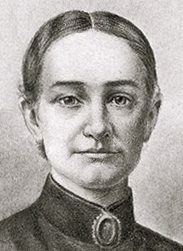 The old West was a rugged, unforgiving place, and for a long time it was thought to be a man’s place, and completely unsafe for women. Men went west, mined for gold, and came home to their families. A man would have to be insane to bring his wife and children to the West. Nevertheless, it was really only a matter of time before someone decided that the west was going to be settled, and it was going to take both men and women to settle the West…otherwise it was always going to be a job site and not a home. Someone had to make the first move, and I can imagine how the parents of those first women must have felt when their daughters told them they were moving out west. It must have been like thinking, “who was this idiot their daughter has married!” Of course, women had come as far as the Rocky Mountains, so going further wasn’t that strange, but it was still the unknown.
The old West was a rugged, unforgiving place, and for a long time it was thought to be a man’s place, and completely unsafe for women. Men went west, mined for gold, and came home to their families. A man would have to be insane to bring his wife and children to the West. Nevertheless, it was really only a matter of time before someone decided that the west was going to be settled, and it was going to take both men and women to settle the West…otherwise it was always going to be a job site and not a home. Someone had to make the first move, and I can imagine how the parents of those first women must have felt when their daughters told them they were moving out west. It must have been like thinking, “who was this idiot their daughter has married!” Of course, women had come as far as the Rocky Mountains, so going further wasn’t that strange, but it was still the unknown.
On this day in 1836, Narcissa Whitman arrived in Walla Walla, Washington, becoming one of the first Anglo women to settle west of the Rocky Mountains. Narcissa and Marcus Whitman, along with their close friends Eliza and Henry Spalding, had departed from New York earlier that year on the long overland journey to the far western edge of the continent. These days, that trip can be 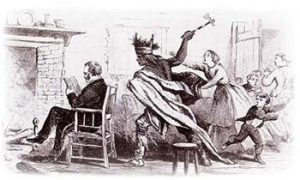 made in a matter of hours, but in those days, it took lots of planning and months to accomplish such a trip. The two couples were missionaries, and Narcissa wrote that they were determined to convert the “benighted ones” living in “the thick darkness of heathenism” to Christianity. I guess there was no specific word for Indians, or Native Americans back then, or she just liked her version better. Mission work was one of the big reasons for heading west…besides land, and gold, of course.
made in a matter of hours, but in those days, it took lots of planning and months to accomplish such a trip. The two couples were missionaries, and Narcissa wrote that they were determined to convert the “benighted ones” living in “the thick darkness of heathenism” to Christianity. I guess there was no specific word for Indians, or Native Americans back then, or she just liked her version better. Mission work was one of the big reasons for heading west…besides land, and gold, of course.
That summer when they crossed the continental divide at South Pass, Narcissa and Eliza became the first Anglo-American women in history to travel west of the Rocky Mountains. I suppose it was like going to another planet to the women, who went with no real idea of what they would be facing in the new frontier. Toward the end of their difficult 1,800 mile journey, the two couples split up, with the Spaldings heading for Idaho while 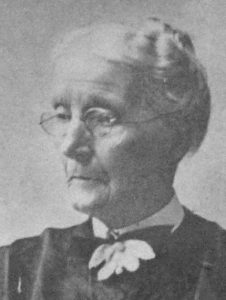 Narcissa and her husband traveled to a settlement near present-day Walla Walla, Washington, where they established a mission for the Cayuse Indians. I can only imagine how the two women must have felt, knowing that it would be a very long time before they had the company of another Anglo woman. For 11 years the couples’ missionary work went well, and they succeeded in converting many of the Cayuse to Christianity. Then in 1847, a devastating measles epidemic swept through the area, killing many of the Cayuse, who had no immunity to the disease, while leaving most of the white people at the mission suspiciously unharmed. Convinced that the missionaries or their god had cursed them with an evil plague, a band of the Cayuse Indians attacked the mission and killed 14 people, including Narcissa and her husband on November 29, 1847. Narcissa Whitman thus became not only one of the first white women to live in the Far West, but also one of the first white women to die there too. She was just 39 years old at the time she was murdered.
Narcissa and her husband traveled to a settlement near present-day Walla Walla, Washington, where they established a mission for the Cayuse Indians. I can only imagine how the two women must have felt, knowing that it would be a very long time before they had the company of another Anglo woman. For 11 years the couples’ missionary work went well, and they succeeded in converting many of the Cayuse to Christianity. Then in 1847, a devastating measles epidemic swept through the area, killing many of the Cayuse, who had no immunity to the disease, while leaving most of the white people at the mission suspiciously unharmed. Convinced that the missionaries or their god had cursed them with an evil plague, a band of the Cayuse Indians attacked the mission and killed 14 people, including Narcissa and her husband on November 29, 1847. Narcissa Whitman thus became not only one of the first white women to live in the Far West, but also one of the first white women to die there too. She was just 39 years old at the time she was murdered.
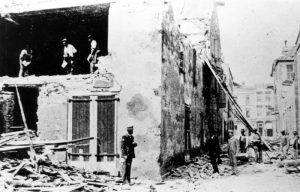 For some reason, there are certain areas on the United States, and the world, where earthquakes are…unexpected. There are just no real fault lines in these places, and no man-made reasons for it, like mining or drilling. So often people think they live in an area that is completely safe from an earthquake. Nevertheless, that does not mean that an earthquake can’t happen, as the people of Charleston, South Carolina found out on August 31, 1886.
For some reason, there are certain areas on the United States, and the world, where earthquakes are…unexpected. There are just no real fault lines in these places, and no man-made reasons for it, like mining or drilling. So often people think they live in an area that is completely safe from an earthquake. Nevertheless, that does not mean that an earthquake can’t happen, as the people of Charleston, South Carolina found out on August 31, 1886.
The first indicator that something strange was going on, came on August 27 and 28, when foreshocks were felt in Summerville, South Carolina, where my first cousin once removed, Stephanie Willard and her family live. While the tremors were odd, the people of the area didn’t think they were a warning for what was coming. Then, at 9:51pm on August 31, the rumbling began. The 7.6 magnitude quake was felt as far away as Boston, Chicago and Cuba. Buildings as far away as far away as Ohio and Alabama were damaged. But, it was Charleston, South Carolina, that took the biggest hit from the quake. Almost all of the buildings in town were seriously damaged. About 14,000 chimneys fell from the earthquake’s shaking. It caused multiple fires, and 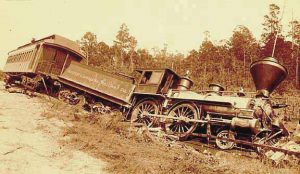 water lines and wells were ruptured. The total damage was in excess of $5.5 million, which would be about $112 million today.
water lines and wells were ruptured. The total damage was in excess of $5.5 million, which would be about $112 million today.
While that was a disaster in itself, it was the loss of life that was felt the worst. More that 100 people lost their lives that fateful day, and countless others were injured, in what is still the largest recorded earthquake in the history of the southeastern United States. The quake damaged as many as 2,000 buildings, including buildings as far away as central Alabama, central Ohio, eastern Kentucky, southern Virginia and western West Virginia. The strange part about this quake is the fact that there were no apparent surface cracks as a result of this tremor, railroad tracks were bent in all directions in some locations. Acres of land were liquefied. This quake remained a mystery for many years since there were no known underground faults for 60 miles in any direction. Then, as science and detection methods got better, scientists have recently uncovered a concealed fault along the coastal plains of Virginia and the Carolinas. While this fault is now known, scientists think that another quake of this magnitude remains highly 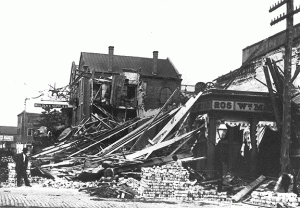 unlikely, though not impossible, in this location.
unlikely, though not impossible, in this location.
I guess I don’t quite understand that concept, except to say that if it is the only fault and has nothing to connect to, maybe there is less chance of a small tremor turning into a big quake, and maybe that is why they don’t expect another quake of that magnitude. Still, it is always good advise to realize that no place is immune to earthquakes. Oklahoma has found that out in recent years, as underground mining work has created quake situations that weren’t there before. It is still my hope that the Charleston area never has another quake like the one they had in 1886.
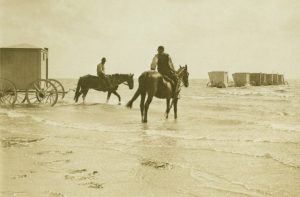 In the 18th and 19th century, going swimming was not done in the same way as it was today. While it was considered ok to swim, the clothing was not considered appropriate, and so men and women were segregated during swimming. I don’t suppose going to the beach was as common, and so it problem might not have come up every day, but it came up enough to create a need for a “proper” way to accomplish an outing involving swimming. Enter the Bathing Machine. The bathing machine was basically a small room built on wheels that could be taken to the beach. People entered the machine while it was on the beach, wearing their street clothing. In the machine they changed into their bathing suit, although men were allowed to bathe nude until the 1860s. They then placed their street clothes into a raised compartment in the bathing machine, where they would remain safe and dry.
In the 18th and 19th century, going swimming was not done in the same way as it was today. While it was considered ok to swim, the clothing was not considered appropriate, and so men and women were segregated during swimming. I don’t suppose going to the beach was as common, and so it problem might not have come up every day, but it came up enough to create a need for a “proper” way to accomplish an outing involving swimming. Enter the Bathing Machine. The bathing machine was basically a small room built on wheels that could be taken to the beach. People entered the machine while it was on the beach, wearing their street clothing. In the machine they changed into their bathing suit, although men were allowed to bathe nude until the 1860s. They then placed their street clothes into a raised compartment in the bathing machine, where they would remain safe and dry.
I believe that all bathing machines had small windows, but one writer in the Manchester Guardian of May 26, 1906 considered them “ill-lighted” and wondered why bathing machines were not improved with a skylight. Once the person had changed, the machine would be wheeled or slid into the water. The most common type of these machines had large wide wheels and were pulled in and out of the surf by a horse or a pair of horses with a driver, but there were some that were pushed in and out of the water by human power. Some resorts had wooden rails into the water for the wheels to roll on, and a few had bathing machines pulled in and out by cables propelled by a steam engine.
Once the machine was in the water, the occupants stepped out from the sea side, and proceeded down steps into the water. Many of the machines had doors front and back, but those with only one door would be backed into the sea or need to be turned around. The most essential element of the machines, was that it blocked any view of the bather from the shore. Some of the more luxurious machines were equipped with a canvas tent lowered from the seaside door, sometimes capable of being lowered to the water, giving the bather greater privacy. Bathing machines would often be equipped with a small flag which could be raised by the bather as a signal to the driver that they were ready to return to shore. Some resorts even employed a dipper, a strong 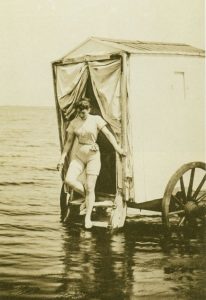 person of the same sex who would assist the bather in and out of the sea. Some dippers were said to push bathers into the water, then yank them out, considered part of the experience. Wow!! I’m not sure I would like that much, but then, to me this whole process seems like it would make the idea of bathing a bit too much of an undertaking, not to mention the added cost to go swimming, because I don’t think anyone would operate a bathing machine for free.
person of the same sex who would assist the bather in and out of the sea. Some dippers were said to push bathers into the water, then yank them out, considered part of the experience. Wow!! I’m not sure I would like that much, but then, to me this whole process seems like it would make the idea of bathing a bit too much of an undertaking, not to mention the added cost to go swimming, because I don’t think anyone would operate a bathing machine for free.
Bathing machines were most commonly used in the United Kingdom and parts of the British Empire with a British population, but were also used in France, Germany, the United States, Mexico, and other nations. Legal segregation of bathing areas in Britain ended in 1901, and the bathing machine declined rapidly. By the start of the 1920s, bathing machines were almost extinct, even on beaches catering to an older clientele. For those of us who grew up in the modern era, this process would seem like a bit of insanity, but then that was simply a different time.
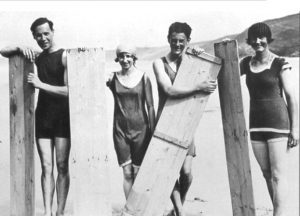
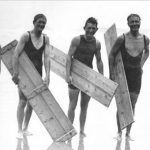 Most of us think of surfing as a sport that began with the 60s Hippie Generation…or at least, I did, but surfing is actually one of the oldest practiced sports in the world. Thought of as, the art of wave riding, it is a blend of total athleticism and the comprehension of the beauty and power of nature. Surfing is also one of the few sports that creates its own culture and lifestyle. From surfing came the beach bum, and the draw of the coastal areas. Surfing began with a wooden board in Western Polynesia over three thousand years ago. The first surfers were actually fishermen who discovered riding waves as an efficient method of getting to shore with their catch. After realizing that surfing was fun, catching waves changed from being part of everyday work to being a pastime, and the sport of surfing was born. I have never considered surfing myself, but I think it is interesting to watch.
Most of us think of surfing as a sport that began with the 60s Hippie Generation…or at least, I did, but surfing is actually one of the oldest practiced sports in the world. Thought of as, the art of wave riding, it is a blend of total athleticism and the comprehension of the beauty and power of nature. Surfing is also one of the few sports that creates its own culture and lifestyle. From surfing came the beach bum, and the draw of the coastal areas. Surfing began with a wooden board in Western Polynesia over three thousand years ago. The first surfers were actually fishermen who discovered riding waves as an efficient method of getting to shore with their catch. After realizing that surfing was fun, catching waves changed from being part of everyday work to being a pastime, and the sport of surfing was born. I have never considered surfing myself, but I think it is interesting to watch.
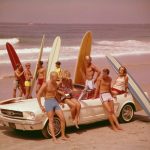
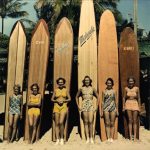
While I’m not a faithful fan of surfing, I do find it interesting to note the different boards surfers have used over the years. The first boards were little more than a wooden plank, and I have to wonder how the surfer ever got to shore. It would seem to me that without the smooth rounded or pointed front edge, the board would simple dig up the water, dumping the surfer in. And maybe that was the problem. It didn’t take long before the loyal surfer was smoothing the edges of his board to make it more streamlined in the water.
Recently, I came across a picture of some young surfers in the 1920s, and while their suits were odd for our day and age, the thing that shocked me the most was their boards. They were literally a wooden plank, squared off at the end, with braces in a couple of placed in the middle. I began to wonder how they could even 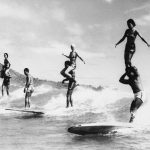
 make them work. The I started looking at other surf boards through the years. They went from the tiny Boogie Board, used for body surfing, to a surf board that looked like a small boat. I wondered how the surfer even carried that board…or transported it. Those big boat sized boards were often more than twice the size of some of the women standing in front of them. I think it is quite interesting that people have been able to use such a wide variety of boards, and actually manage to navigate the waves without falling in every time, but then I guess practice makes perfect.
make them work. The I started looking at other surf boards through the years. They went from the tiny Boogie Board, used for body surfing, to a surf board that looked like a small boat. I wondered how the surfer even carried that board…or transported it. Those big boat sized boards were often more than twice the size of some of the women standing in front of them. I think it is quite interesting that people have been able to use such a wide variety of boards, and actually manage to navigate the waves without falling in every time, but then I guess practice makes perfect.
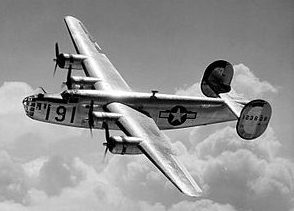
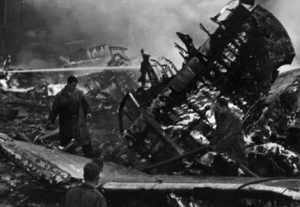 Airplane disasters are always horrible, but sometimes the circumstances just don’t seem to fit the disaster. During World War II, the US Army Air Forces were stationed in bases around the world, mostly for quick access to air targets, but with the added benefit for the people in the area of some protection from enemy forces. Just having the planes in the area tended to be a deterrent for the enemy planes, who did not want to be attacked in great numbers. Planes like the B-17, B-24, and others regularly flew over the towns near their bases. One such flight…unfortunately ended in a disaster.
Airplane disasters are always horrible, but sometimes the circumstances just don’t seem to fit the disaster. During World War II, the US Army Air Forces were stationed in bases around the world, mostly for quick access to air targets, but with the added benefit for the people in the area of some protection from enemy forces. Just having the planes in the area tended to be a deterrent for the enemy planes, who did not want to be attacked in great numbers. Planes like the B-17, B-24, and others regularly flew over the towns near their bases. One such flight…unfortunately ended in a disaster.
On August 23, 1944, a pair of newly refurbished B-24 Liberator heavy bombers were being taken on a test flight, prior to their delivery to the 2nd Combat Division. The planes departed US Army Air Force Base Air Depot 2 and Warton Aerodrome at 10:30am. Due to an impending potentially violent storm, both planes were recalled. Unfortunately, by the time they returned, to the vicinity of the Aerodrome, the wind and rain had significantly reduced visibility. Newspaper reports detailed wind velocities approaching 60 mph, water spouts in the Ribble Estuary and flash flooding in Southport and Blackpool. As the two planes flew in formation from the west toward runway 08, the pilot of the B-24H-20-CF Liberator, US aircraft serial number 42-50291, named “Classy Chassis II”, 1st Lieutenant John Bloemendal, reported to the control tower that he was aborting landing at the last moment and would “go around.”
Shortly afterwards, and out of visibility of the second aircraft, the aircraft hit the village of Freckleton, just east of the airfield. As it came down, the B-24 Liberator heavy bomber crashed into the center of the village of Freckleton, Lancashire, England. The aircraft crashed into the Holy Trinity Church of England School, demolishing three houses and the Sad Sack Snack Bar. The death toll was 61, including 38 children.
The plane was already flying very low, and for whatever reason, the wings were very nearly vertical. The plane’s right wing tip hit a tree top, and was ripped away as it impacted the corner of a building. The rest of the wing continued, plowing along the ground and through a hedge. The fuselage of the 25 ton bomber continued, partly demolishing three houses and the Sad Sack Snack Bar, before crossing Lytham Road and bursting into flames. A part of the aircraft hit the infants’ wing of Freckleton Holy Trinity School. Fuel from the ruptured tanks ignited and produced a sea of flames. In the school, 38 schoolchildren and six adults were killed. The clock in one classroom stopped at 10:47 am. In the Sad Sack Snack Bar, which catered specifically to American servicemen from the air-base, 14 were killed…seven Americans, four Royal Air Force airmen and three civilians. The three crew members on the B-24 were also killed.
The official report stated that the exact cause of the crash was unknown, but concluded that the pilot had not fully realized the danger the storm posed until underway in his final approach, by which time he had insufficient altitude and speed to maneuver given the probable strength of wind and downdrafts that must have prevailed. Structural failure of the aircraft in the extreme conditions was not ruled out, although the complete destruction of the B-24 prevented any meaningful investigation. Because many of the pilots coming to the England commonly believed that British storms were little more than showers, it was recommended that all US trained pilots should be emphatically warned of the dangers of British thunderstorms. A memorial garden and 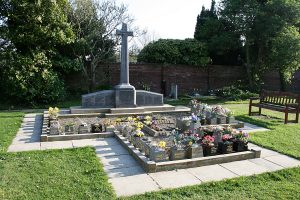
 children’s playground were opened in August 1945, in memory of those lost, the money for the playground equipment having been raised by American airmen at the Warton airbase. A fund for a memorial hall was started, and the hall was finally opened in September 1977. Another memorial in the village churchyard was placed at the accident site in 2007. The plane that had come to signify protection for the area people, in the end spelled friendly disaster.
children’s playground were opened in August 1945, in memory of those lost, the money for the playground equipment having been raised by American airmen at the Warton airbase. A fund for a memorial hall was started, and the hall was finally opened in September 1977. Another memorial in the village churchyard was placed at the accident site in 2007. The plane that had come to signify protection for the area people, in the end spelled friendly disaster.

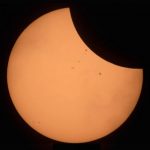 With yesterday’s eclipse, came a massive amount of videos and photos documenting the event. Before it was even over, people all over the world were able to view the event. NASA filmed it and posted it on their website…including the moments when the International Space Station flew in front of it!! It was an awesome way for people, who were unable to get to the path of totality, to view the event. While we give little thought to such abilities today, just a few years back, they would have seemed impossible, or at the very least, they would have shocked us. That’s because we have things like television, internet, cell phones, and digital cameras…but they didn’t then. The television was looked upon as a fad that would never take hold. People simply wouldn’t spend the money on one. How very wrong they were.
With yesterday’s eclipse, came a massive amount of videos and photos documenting the event. Before it was even over, people all over the world were able to view the event. NASA filmed it and posted it on their website…including the moments when the International Space Station flew in front of it!! It was an awesome way for people, who were unable to get to the path of totality, to view the event. While we give little thought to such abilities today, just a few years back, they would have seemed impossible, or at the very least, they would have shocked us. That’s because we have things like television, internet, cell phones, and digital cameras…but they didn’t then. The television was looked upon as a fad that would never take hold. People simply wouldn’t spend the money on one. How very wrong they were.
Lets travel back in time to when television first came out. All the people had were radios to hear about the things that were going on…or the newspapers. There was simply no way to show the people what an eclipse looked like, unless they saw it for themselves. No way to warn them of the serious dangers of looking at it. Things like that were by trial and error. Not only that, but they really couldn’t predict and eclipse. And space travel…what was that? Nevertheless, the dawning of a new age was upon them. The days of being in the dark when it came to world events was about to end. And television would bring with it so much more than just the news. Still, the television, when it first made its appearance on the planet, cost a lot of money. Far to much money for the average family to spend on the new fangled contraption, so few people had one. That didn’t stop the kids, and even adults, from watching it in the store windows, they just didn’t get to watch it very often.
As time went by, the prices of televisions came down, and people realized that this wasn’t just a passing fad. 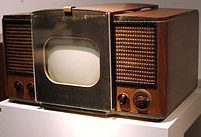
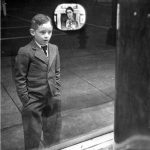 These days, nearly every household in the United States, if not the world has one, and those who don’t, have likely chosen to walk away from the television. And we aren’t even tied to our homes to watch television now. We can watch it from our computers or even our cell phones. Wow!! How far we have come. News is only new for a few seconds, and by the time stories come out in the paper, they have already been read on the internet. Before long, I’m sure the newspaper will become obsolete…if it hasn’t already.
These days, nearly every household in the United States, if not the world has one, and those who don’t, have likely chosen to walk away from the television. And we aren’t even tied to our homes to watch television now. We can watch it from our computers or even our cell phones. Wow!! How far we have come. News is only new for a few seconds, and by the time stories come out in the paper, they have already been read on the internet. Before long, I’m sure the newspaper will become obsolete…if it hasn’t already.
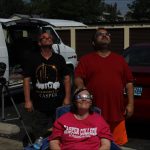
 Today’s solar eclipse will not be the first one I have ever seen, but it will be the first total solar eclipse I have ever seen. I most clearly recall the July 10, 1972 eclipse. It was a warm sunny day, and downtown Casper, Wyoming had set up a viewing telescope for those who wanted to have a look. Casper was not in the path of totality, so crowds were not an issue like they are this time. I find myself somewhat stunned that Casper is one of the best sites to view today’s eclipse. Casper isn’t usually a big tourist attraction, but today, we have found ourselves at the center of all the hoopla.
Today’s solar eclipse will not be the first one I have ever seen, but it will be the first total solar eclipse I have ever seen. I most clearly recall the July 10, 1972 eclipse. It was a warm sunny day, and downtown Casper, Wyoming had set up a viewing telescope for those who wanted to have a look. Casper was not in the path of totality, so crowds were not an issue like they are this time. I find myself somewhat stunned that Casper is one of the best sites to view today’s eclipse. Casper isn’t usually a big tourist attraction, but today, we have found ourselves at the center of all the hoopla.
I’ve watched a movie about viewing a total eclipse, and people come away feeling…somehow changed after viewing one. My mind can’t seem to wrap itself around how that could happen, but I guess I’ll see how I feel afterward. For me, I think that if I feel a change it will be more because I think that the signs of the sky were placed there by God, to speak to His people. Many people may think that’s crazy, but it’s no more strange than to think that it’s accidental. The whole universe was created by God, so why wouldn’t He plan it’s every move.
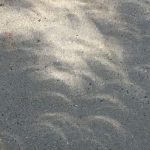
So, the eclipse is over now, and I must say that the moments in totality were…amazing. The color of the atmosphere around us was not like the typical, dusk that everyone said to expect. It was different than that somehow. My son-in-law, Kevin Petersen thought so too. While we were waiting for totality, I tried to look at the things everyone said to watch for, and probably the most surprising to me was the eclipse shadows. I don’t know what I thought it would look like, but when I saw it, I startled my daughter, Corrie Petersen; my son-in-law, Kevin; and my husband, Bob Schulenberg. I shouted, “Look!! It’s the eclipse shadows!!” They are actually called Solar Eclipse Crescent Shadows. Well, my family thought I saw a snake or something, hahaha!! We also noticed, as expected, that the birds started their evening song ritual, preparing to go to sleep for the night. We might have heard crickets, but the people around us set off fireworks at that time, so we couldn’t hear that. We saw the sunset along the horizon, and afterward we had to laugh, because we all forgot to look for the stars. I caught a very faint glimpse of them in a picture I took.
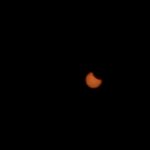

Totality was an amazing experience, but I like most people think that 2 minutes and 26 seconds is a very short time. You simply don’t have time to see everything that there was to see. The cool air was, in reality, a welcome change from the heat we had been sitting in, but like the rest of the eclipse, it didn’t last very long. With the return of the sun, came the warmth of the sun again. Totality was over, and yes, maybe I was changed. I had experienced a total eclipse, and it was amazing. It was something I will never forget.
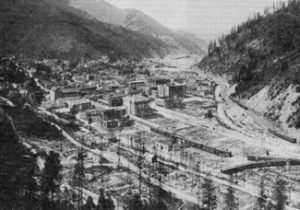
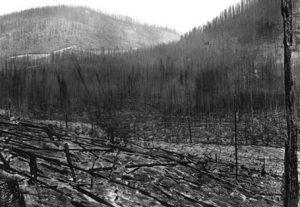 With summer, and especially late summer, when things are beginning to dry up, comes an increased danger of wildfires. Add to that, an extremely dry spring and early summer, and you have a recipe for disaster. Such was the case in northwest Washington, northern Idaho, and western Montana in 1910. There were a great number of problems that contributed to an over active fire season, and ultimately, the destruction that began on August 20, 1910, quickly became a firestorm that burned about three million acres…a full 4,700 square miles before it was over. The areas burned included parts of the Bitterroot, Cabinet, Clearwater, Coeur d’Alene, Flathead, Kaniksu, Kootenai, Lewis and Clark, Lolo, and Saint Joe National Forests. The extensive burned area was approximately the size of the state of Connecticut. The extreme scorching heat of the sudden blowup can be attributed to the great Western White Pine forests that blanketed Idaho. The hydrocarbons in the resinous sap boiled out and created a cloud of highly flammable gas that blanketed hundreds of square miles, which then spontaneously detonated dozens of times, each time sending tongues of flame thousands of feet into the sky, and creating a rolling wave of fire that destroyed anything and everything in its path.
With summer, and especially late summer, when things are beginning to dry up, comes an increased danger of wildfires. Add to that, an extremely dry spring and early summer, and you have a recipe for disaster. Such was the case in northwest Washington, northern Idaho, and western Montana in 1910. There were a great number of problems that contributed to an over active fire season, and ultimately, the destruction that began on August 20, 1910, quickly became a firestorm that burned about three million acres…a full 4,700 square miles before it was over. The areas burned included parts of the Bitterroot, Cabinet, Clearwater, Coeur d’Alene, Flathead, Kaniksu, Kootenai, Lewis and Clark, Lolo, and Saint Joe National Forests. The extensive burned area was approximately the size of the state of Connecticut. The extreme scorching heat of the sudden blowup can be attributed to the great Western White Pine forests that blanketed Idaho. The hydrocarbons in the resinous sap boiled out and created a cloud of highly flammable gas that blanketed hundreds of square miles, which then spontaneously detonated dozens of times, each time sending tongues of flame thousands of feet into the sky, and creating a rolling wave of fire that destroyed anything and everything in its path.
That summer had been described as “like no others.” The drought resulted in forests that were filled with dry fuel, which had previously grown up on abundant autumn and winter moisture. Fires were set by hot cinders flung from locomotives, sparks, lightning, and backfiring crews, and by mid-August, there were 1,000 to 3,000 fires burning in Idaho, Montana, Washington, and British Columbia. Then on August 20th, everything blew up into a firestorm. The firestorm burned over two days, August 20 and 21. It killed 87 people, most of them firefighters. The entire 28 man “Lost Crew” was overcome by flames and perished on Setzer Creek in Idaho outside of Avery. The Great Fire of 1910 is believed to be the largest, although not the deadliest, forest fire in United States history. It was commonly referred to as the Big Blowup, the Big Burn, or the Devil’s Broom fire. Smoke from the fire could be seen as far east as Watertown, New York, and as far south as Denver, Colorado. It was reported that at night, five hundred miles out into the Pacific Ocean, ships could not navigate by the stars because the sky was cloudy with smoke.
The fire actually started as many small fires. Then, on August 20, a cold front blew in and brought hurricane-force winds. The wind whipped the hundreds of small fires into one or two blazing infernos. The larger fires were impossible to fight. They simply didn’t have the manpower, or the supplies. The United States Forest Service…then called the National Forest Service…was only five years old at the time and unprepared for the possibilities of this dry summer. Later, at the urging of President William Howard Taft, the United States Army, 25th Infantry Regiment…known as the Buffalo Soldiers, was brought in to help fight the blaze. The most famous story of survival was that of Ed Pulaski, a United States Forest Service ranger who led a large group of his men to safety in an abandoned prospect mine outside of Wallace, Idaho, just as they were about to be overtaken by the fire. Pulaski fought off the flames at the mouth of the shaft until he passed out like the other men. Around midnight, one man said that he was getting out of there. Knowing that they would have no 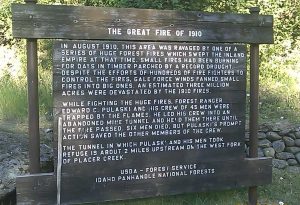
 chance of survival if they ran, Pulaski drew his pistol. He threatened to shoot the first person who tried to leave. In the end, all but five of the forty or so men survived. Several towns were completely destroyed by the fire. The fire was finally extinguished when another cold front swept in, bringing with it, steady rain. Unfortunately, it was too late for the 87 people who lost their lives in the blaze. Memorials were placed in several of the fire areas.
chance of survival if they ran, Pulaski drew his pistol. He threatened to shoot the first person who tried to leave. In the end, all but five of the forty or so men survived. Several towns were completely destroyed by the fire. The fire was finally extinguished when another cold front swept in, bringing with it, steady rain. Unfortunately, it was too late for the 87 people who lost their lives in the blaze. Memorials were placed in several of the fire areas.

 After the Revolutionary War, and the United States independence that followed, the relationship between the two nations was quite strained. The United States did not like having British military posts on our northern and western borders, and Britain’s violation of American neutrality in 1794 when the Royal Navy seized American ships in the West Indies during England’s war with France. Finally, in an attempt to smooth things over, Supreme Court Chief Justice John Jay, who was appointed by President Washington, came up with a treaty. The treaty officially known as the “Treaty of Amity Commerce and Navigation, between His Britannic Majesty; and The United States of America” was signed by Britain’s King George III on November 19, 1794 in London. However, after Jay returned home with news of the treaty’s signing, President Washington, who was now in his second term, had encountered fierce Congressional opposition to the treaty. By 1795, its ratification was still uncertain, and there was work to be done to change things.
After the Revolutionary War, and the United States independence that followed, the relationship between the two nations was quite strained. The United States did not like having British military posts on our northern and western borders, and Britain’s violation of American neutrality in 1794 when the Royal Navy seized American ships in the West Indies during England’s war with France. Finally, in an attempt to smooth things over, Supreme Court Chief Justice John Jay, who was appointed by President Washington, came up with a treaty. The treaty officially known as the “Treaty of Amity Commerce and Navigation, between His Britannic Majesty; and The United States of America” was signed by Britain’s King George III on November 19, 1794 in London. However, after Jay returned home with news of the treaty’s signing, President Washington, who was now in his second term, had encountered fierce Congressional opposition to the treaty. By 1795, its ratification was still uncertain, and there was work to be done to change things.
The two biggest opponents to the treaty were two future presidents…Thomas Jefferson and James Madison. Jefferson was, at the time, in between political positions. He had just completed a term as Washington’s secretary of state from 1789 to 1793 and had not yet become John Adams’ vice president. Fellow Virginian, James Madison was a member of the House of Representatives. Jefferson, Madison and other opponents feared the treaty gave too many concessions to the British. They argued that Jay’s negotiations actually weakened American trade rights and complained that it committed the United States to paying pre-revolutionary debts to English merchants. Washington himself was not completely satisfied with the treaty, but considered preventing another war with America’s former colonial master a priority.
The treaty was finally approved by Congress on August 14, 1795, with exactly the two-thirds majority it needed 
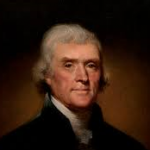 to pass. President Washington signed the treaty just four days later, on August 18, 1795. Washington and Jay may have won the legislative battle and averted war temporarily, but it created a conflict at home that highlighted a deepening division between those of different political ideologies in Washington DC, much like what we see these days. Jefferson and Madison mistrusted Washington’s attachment to maintaining friendly relations with England over revolutionary France, who would have welcomed the United States as a partner in an expanded war against England.
to pass. President Washington signed the treaty just four days later, on August 18, 1795. Washington and Jay may have won the legislative battle and averted war temporarily, but it created a conflict at home that highlighted a deepening division between those of different political ideologies in Washington DC, much like what we see these days. Jefferson and Madison mistrusted Washington’s attachment to maintaining friendly relations with England over revolutionary France, who would have welcomed the United States as a partner in an expanded war against England.
 As the pioneers headed west, there were various disputes over ownership of the lands they were settling into. The Native American people did not think that they should have to surrender their lands to the White Man, but it seemed that they had no choice. Still, there were some Native Americans who refused to be pushed around by the government. On August 17, 1862, violence erupted in Minnesota as desperate Dakota Indians attacked white settlements along the Minnesota River. This was a fight that the Dakota Indians would eventually lose. They were no match for the US military, and six weeks later, it was over.
As the pioneers headed west, there were various disputes over ownership of the lands they were settling into. The Native American people did not think that they should have to surrender their lands to the White Man, but it seemed that they had no choice. Still, there were some Native Americans who refused to be pushed around by the government. On August 17, 1862, violence erupted in Minnesota as desperate Dakota Indians attacked white settlements along the Minnesota River. This was a fight that the Dakota Indians would eventually lose. They were no match for the US military, and six weeks later, it was over.
The Dakota Indians were often referred to as the Sioux, which I did not know was a derogatory name derived from part of a French word meaning “little snake.” It almost makes it seem like they were talking badly about them to their face, but so they couldn’t understand it. The government treated the Dakota poorly, and the Dakota saw their hunting lands dwindling 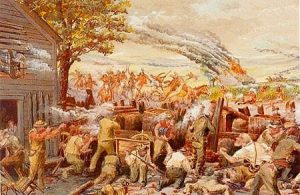 down, and apparently the provisions that the government promised to supply, rarely arrived. And now, to top it off, a wave of white settlers surrounded them too. To make matters worse, the summer of 1862 had been a harsh one, and cutworms had destroyed much of the crops. The Dakota were starving.
down, and apparently the provisions that the government promised to supply, rarely arrived. And now, to top it off, a wave of white settlers surrounded them too. To make matters worse, the summer of 1862 had been a harsh one, and cutworms had destroyed much of the crops. The Dakota were starving.
On August 17, the situation exploded when four young Dakota warriors returning from an unsuccessful hunt, stopped to steal some eggs from a white settlement. The were caught and they picked a fight with the hen’s owner. The encounter turned tragic when the Dakotas killed five members of the family. Now, the Dakota knew that they would be attacked. Dakota leaders, knew that war was at hand, so they seized the initiative. Led by Taoyateduta, also known as Little Crow, the Dakota attacked local agencies and the settlement of New 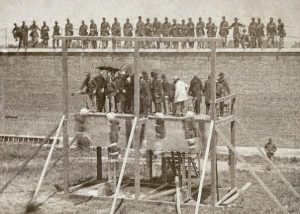 Ulm. Over 500 white settlers lost their lives along with about 150 Dakota warriors.
Ulm. Over 500 white settlers lost their lives along with about 150 Dakota warriors.
President Abraham Lincoln dispatched General John Pope, fresh from his defeat at the Second Battle of Bull Run, Virginia. Pope was to organize the Military Department of the Northwest. Some of the Dakota immediately fled Minnesota for North Dakota, but more than 2,000 were rounded up and over 300 warriors were sentenced to death. President Lincoln commuted most of their sentences, but on December 26, 1862, 38 Dakota men were executed at Mankato, Minnesota. It was the largest mass execution in American history, and it was all because they were starving, and had no hope of living through that year.

